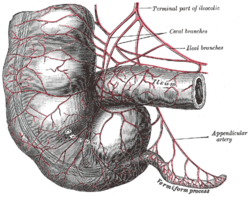Vermiform process
| Appendix | |
|---|---|

Drawing of colon with variability of appendix as seen from front
|
|

Arteries of cecum and appendix (appendix labeled as vermiform process at lower right)
|
|
| Details | |
| Precursor | Midgut |
| System | Digestive system |
| Artery | Appendicular artery |
| Vein | Appendicular vein |
| Identifiers | |
| Latin | Appendix vermiformis |
| MeSH | A03.556.124.526.209.290 |
| Dorlands /Elsevier |
Vermiform appendix |
| TA | A05.7.02.007 |
| FMA | 14542 |
|
Anatomical terminology
[]
|
|
The appendix (or vermiform appendix; also cecal [or caecal] appendix; vermix; or vermiform process) is a blind-ended tube connected to the cecum, from which it develops in the embryo. The cecum is a pouchlike structure of the colon, located at the junction of the small and the large intestines.
The term "vermiform" comes from Latin and means "worm-shaped".
The human appendix averages 9 cm in length but can range from 2 to 20 cm. The diameter of the appendix is usually between 7 and 8 mm. The longest appendix ever removed was 26 cm long; it was removed from a patient in Zagreb, Croatia. The appendix is usually located in the lower right quadrant of the abdomen, near the right hip bone. The base of the appendix is located 2 cm beneath the ileocecal valve that separates the large intestine from the small intestine. Its position within the abdomen corresponds to a point on the surface known as McBurney's point.
The appendix is connected to the mesentery in the lower region of the ileum, by a short region of the mesocolon known as the mesoappendix.
Some identical twins—known as mirror image twins—can have a mirror-imaged anatomy, a congenital condition with the appendix located in the lower left quadrant of the abdomen.Intestinal malrotation may also cause displacement of the appendix to the left side.
...
Wikipedia
